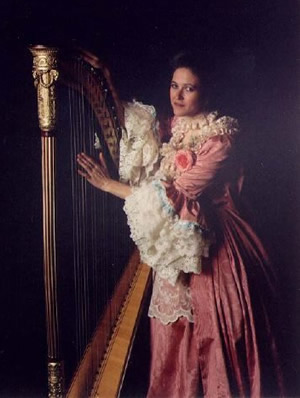
I found the Chaillot harp in an antique store in Salem in 1987. Once rescued from an ignoble fate as “antique furniture” it languished under my bed in pieces until 5 years later I had the opportunity to re-build it. As I took apart the column I found an inscription inside the action plate dating the harp from June of 1892, serial number 229. The address of the Chaillot harp company is given on the action plate as being at number 338 on Rue Saint Honore in Paris.
The soundboard had to be replaced since all the glue had disintegrated. As we took off the old soundboard we discovered the original screw holes in the body of the harp along side the more recent holes, indicating that the board had been replaced at least once before. We hand rubbed the action plate and all the disks with steel wool and re-finished them with new lacquer. The A and D pedals are in good shape, except for the A which had been sorely bent. We straightened it out and put new leathers strips around all the pedals. Modern pedal harps now use felt for this purpose. The E and B pedals are particularly worn, with only about two inches showing outside the base.
We spent much effort in cleaning, building up and re-carving the gilded column with acrylic plaster. Then we carefully matched bronze powder paint on top of a red base coat. Local artist Margaret Puckett painted the soundboard with flowers and insects.
Next came the dilemma of stringing the harp. I found that I could use regular pedal harp strings placed an octave lower for less tension. The bass wire strings were a problem until I discovered that nylon filament wound with copper or silver simulates the silk core strings used originally.
The process of regulating a single-action pedal mechanism at first glance should be easier than regulating the modern double action mechanism. But the process is tedious indeed, since each adjustment must be made with a series of tiny metal washers, which serve as shims. Through laborious trial and error the right combination of thickness is arrived upon for each disk.
After six months of intense work the Chaillot harp was once again singing with it’s original voice, and what a voice it has. The tone is lute-like, with a tinkling upper register, sonorous mid-range, and slightly boomy low end. Three distinct registers sound like three different instruments. The delicate touch of the low-tension gut strings makes this harp ideal for late 18th and early 19th century repertoire.
